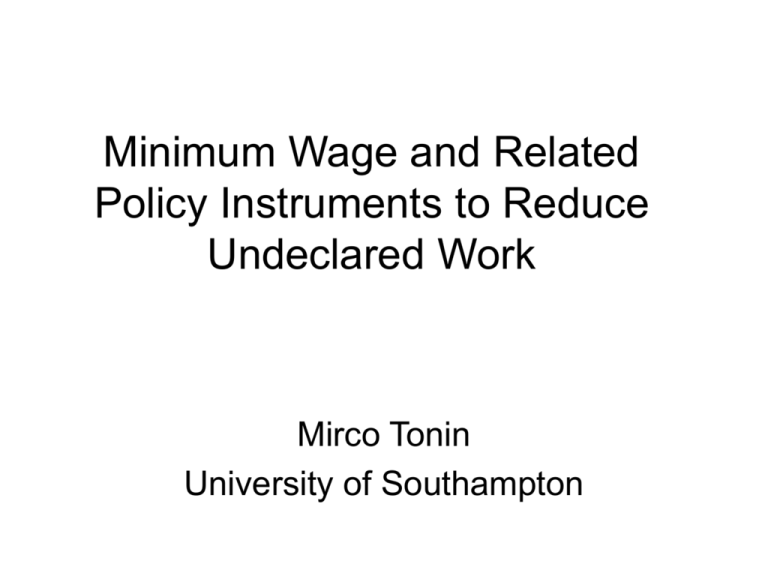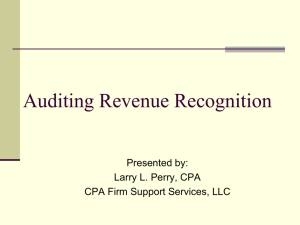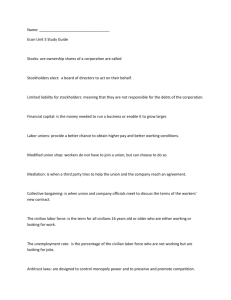Minimum Wage and Related Policy Instruments to
advertisement

Minimum Wage and Related Policy Instruments to Reduce Undeclared Work Mirco Tonin University of Southampton Outline Discuss the role of policies establishing some sort of “minimal thresholds” in reducing undeclared work and their application in Hungary 1. The minimum wage as a tax enforcement device: Hungary 2001 2. Contrasting underreporting by employees: the Bulgarian minimum social insurance thresholds 3. Contrasting underreporting by self-employed, SME, professional: the Italian “Business Sector Analysis” Minimum Wage and Tax Evasion: Hungary 2001 • MW is smallest possible amount to be declared to remain in the formal economy • Previous research (Tonin, 2007) shows that 2001 hike was effective in reducing underreporting of earnings by employees in the formal economy • Risk: some workers move from the formal economy into black economy or inactivity Sharpening the tool A single statutory MW is a blunt instrument to fight underreporting! MW can be sharpened by differentiation along dimensions related to productivity • Hungary: differentiation according to job educational requirement • Bulgaria: differentiation along sectoral and occupational dimensions The Bulgarian Case Problem: • massive underreporting of labour compensation Two changes in labour regulation in 2003: • compulsory registration of all concluded, amended, or terminated contracts • introduction of minimum social security thresholds Minimum Social Security Thresholds Varying according to: • occupational group (9 categories, e.g. administrative staff / service workers and sale workers) • sector (48 in 2003, 73 at present, e.g. processing and preserving of fruit and vegetables / manufacture of dairy products) Potentially, 657 different MSIT MINIMUM: 180 leva per month (statutory minimum wage) MAXIMUM: 851 leva per month (management in manufacture of coke, refined petroleum products and nuclear fuel) Minimum Social Security Thresholds (2) • Negotiated each year with social partners (in 2005 for 48 out of 68 sectors) • If no agreement, fixed administratively • MSITs negotiated with social partners usually become sectoral minimum wages through extension of collective agreements • No systematic evaluation, but apparently successful in reducing underreporting Conflict of Interest Recent Proposal by Bulgarian Industrial Association: • Workers liable to a fine in case of underreporting • Exemption from the fine and additional protection against unfair dismissal if worker denounces illegal payments to authorities The Italian Case Problem: • massive underreporting by small and medium enterprises, self-employed, and professionals Introduction in 1998 of “Business Sector Analysis” (Studi di Settore) • methodology to estimate revenues and compensations • hybrid between auditing selection mechanism and presumptive taxation Main Features Elaboration of sector-specific BSA: • 45 in 1998, 200 now, e.g. “Retail sale of flowers, plants and seeds via permanent or mobile stalls”/ “Tour guide activities”/ “Dentistry” • participation of trade associations • publication of results • regular updating Procedure 1. Estimation of revenues (based on sector/ organizational structure/ reference market/ business model/ geographical location/ structural and accounting variables) 2. Declaration : • Accounting Revenues > Estimate? • Taxpayer voluntarily “adjust” to estimate? If yes, taxpayer is “consistent”, if no “inconsistent” 3. Auditing : “inconsistent” taxpayer • higher probability of an auditing • reversal of burden of proof Estimation of Revenues - Macro A. Data Collection - survey of the population of interest to collect structural and accounting data (e.g. for retail sale of flowers approx. 100 questions) B. Identification of Sectoral and Geographical Clusters (e.g. for retail sale of flowers, 8 clusters “flower retailers with kiosk operating nearby cemeteries”) C. Estimation of Revenue Function – regression analysis on selected sample: relationship between revenues and structural and accounting variables Example: “Retail sale of flowers, plants and seeds via permanent or mobile stalls” 6 sectoral clusters (4 displayed) 2 geographical clusters 10 “independent” variables Declaration • Applied to self-employed, professionals, SME with revenues below EUR 5m + other causes of exclusion (approx. 4m firms) • Taxpayer fill in data and knows the amount of estimated revenues • If accounting revenues are lower, can decide to adjust declaration to match estimate (a 3% penalty applies for deviations above 10%) • If taxpayer decide NOT to do so, classified as “inconsistent” Auditing “Inconsistent” taxpayers subject to: • higher probability of auditing • reversal of burden of proof – taxpayer has to document the reasons why revenues are below estimate Examples of acceptable reasons: • illness or maternity • reduced business due to road reconstruction • economic marginality of business activity Assessment Impact at declaration (2004): • • • • 69% “naturally consistent” 15% “consistent by adjustment” => +3bn EUR 16% “inconsistent” evidence of BSA being more effective when recently updated and probability of auditing higher Impact on bookkeeping • not systematically assessed, but most likely important once BSA established The Hungarian Experience Higher probability of an audit if social security contributions paid on a base below twice the minimum wage • mixture of the Bulgarian and Italian systems but much more limited and undifferentiated • possible to move toward a better targeted system? Conclusions • “minimal thresholds” can play a role in reducing underreporting by those in the grey economy • need to target them to avoid encouraging black economy or inactivity • informational requirements (and legitimacy) calls for the active involvement of social partners



